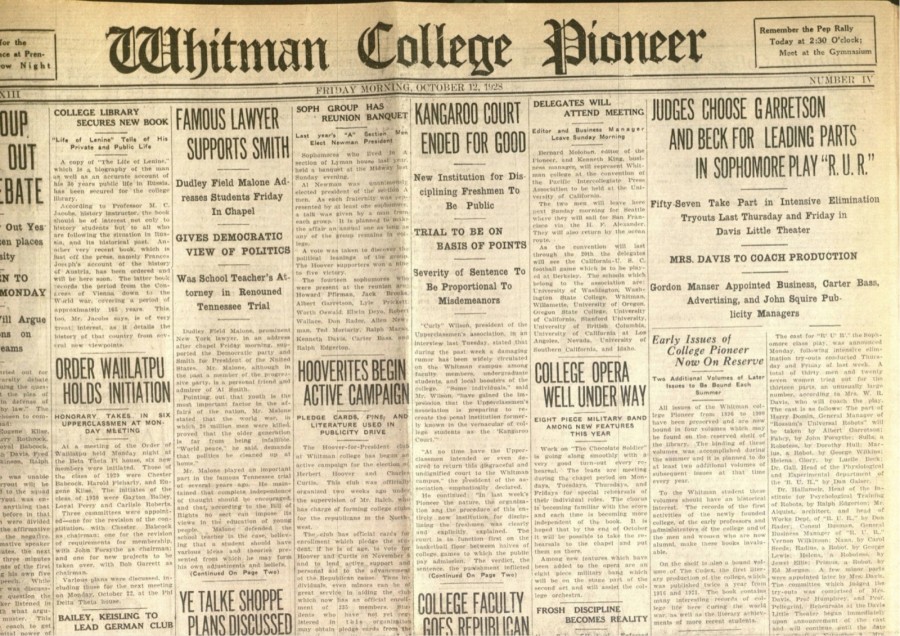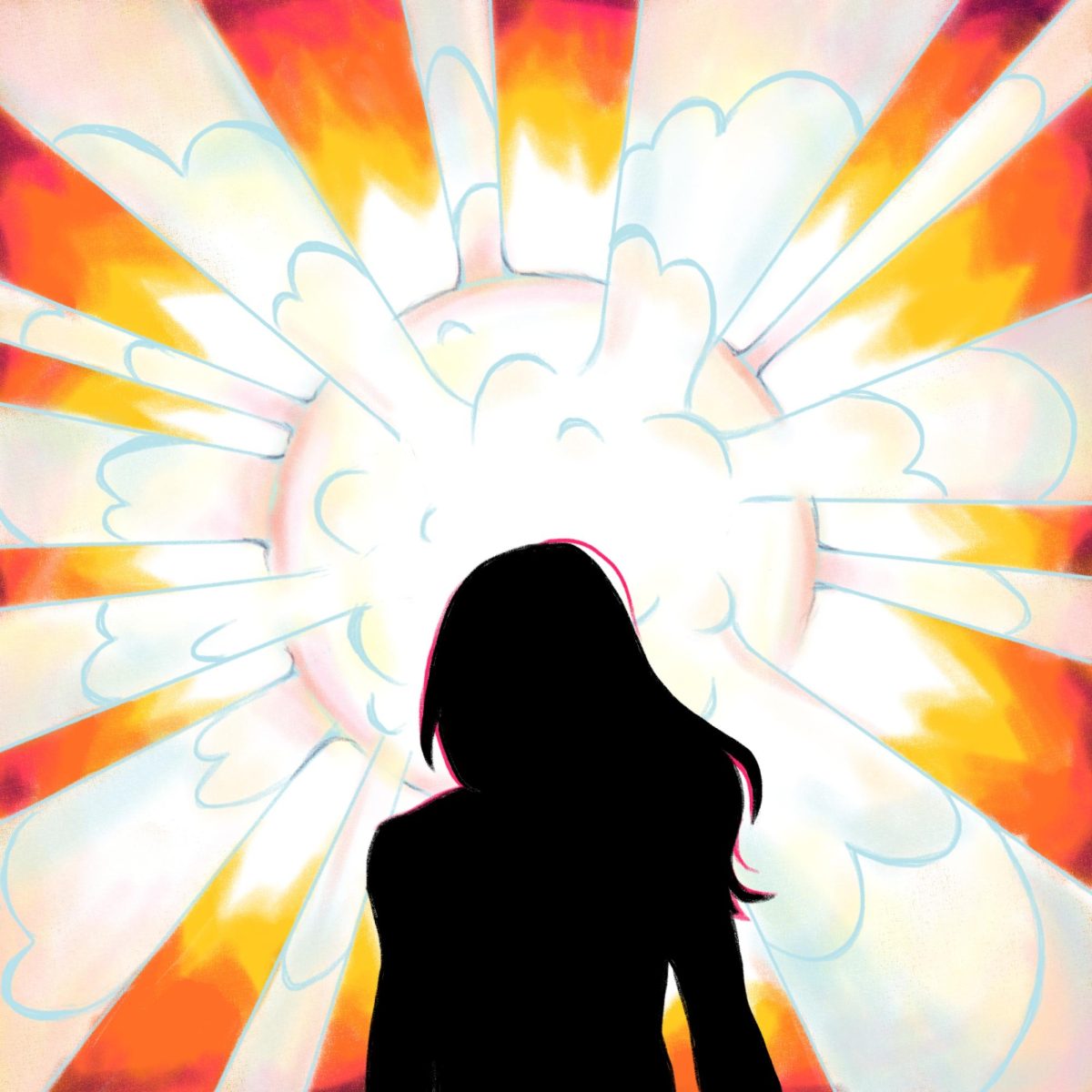Since opening its doors in 1896, the Whitman Pioneer has had a long and diverse history of reporting on campus. While it began its life in an era when there were few enough students to cover each one’s comings and goings in a week’s issue, it gradually transitioned into a record of campus events and competitions and a calendar for annual traditions. In the 1960s it became a bastion of radical politics and the arts, agitating for reform on campus, before taking on a more formal air in the 1980s. Today, photographs and graphics play a large part in the paper, while quotes and hard news are the foundation of Pioneer reporting. We took a look into our archives to get some perspective on where today’s Pioneer is coming from. Here are some samples of headlines from the archives of Whitman’s oldest publication.
[portfolio_slideshow]
1896, November
The Pioneer‘s first issue was published 117 years ago. No pictures or quotations were included in the publication, and news was written in a narrative manner. News pieces include short snippets of information from the personal lives of students, such as when they changed their preferred flavor of tea––small-campus news at its best.
1898, June
Foreshadowing its future in addressing controversial issues around campus, The Pioneer publishes a list of “Gripes,” including the complaint concerning professors skipping class to pursue relationships. Despite The Pio’s reasonable request, no evidence can be found that the administration ever took serious steps to ban falling in love on campus.
1902, October 2nd
By the turn of the century The Pioneer was finding its place at the college, reporting on regular campus events such as sports meets, debate and glee competitions and social occasions. Once ASWC was founded, The Pioneer began regularly reporting on the organization’s meetings and goals. The relationship between the two organizations would evolve over the years, with the two bodies eventually being joined by financing and relations swinging between partnership and rivalry.
1912, Nov. 5, titled “Handsome Stags Get Together on the Whitman Wax”
Throughout the early 1900s The Pioneer reported on an array of campus competitions, sports, activities, social events and student elections. Though The Pioneer has only ever been published in English, the language used has changed significantly over the years. This description of a party provides a glimpse into slang used 101 years ago.
1921, Nov. 18 “‘Justice Must Be Meted’––Koed’s Kangaroo Kourt”
While profiling groups on campus is now a regular occurrence at The Pio, the practice took several years to develop. Then again, modern groups don’t have the acronym KKK or carry out vigilante hazing on campus.
1928, Nov. 16 “Tough Looking He-Men Seen on Whitman Campus”
Unfortunately, illustrations, pictures and graphics were nonexistent for the first several decades of publication. Front-page articles sometimes tried to make up for this through vivid language; this headline described a beard-growing competition in the late ‘20s.
1934, Feb. 16 “Coed Does Everything But Study in ‘Typical’ Evening”
Although today many articles printed in the Pioneer are technically feature piece rather than news on current events, it took several decades for the paper to begin to experiment with this type of reporting. Reports on student life from the paper’s past can provide insight into how the college has (and has not) changed over the decades.
1941 Jan. 8, “Serenades to Campused College Gals”
Despite some of the saucy articles printed by The Pioneer, for many years the campus had strict rules concerning morality. Girls who missed the bedtimes set by the college had the hours they could be out of the dorms restricted.
1949 Sept. 22, “Sidewalks of Whitman”
As Whitman entered a stage of building and development after WWII, The Pioneer kept up to date, covering construction around campus. Sometimes modernization conflicted with tradition, though radical projects such as sidewalks eventually were pushed through. By the time buildings such as Anderson Hall and the Science Building were constructed, change was less controversial.
1955 Sept. 15 “Tug of War Regulated By Executive Council”
In the ‘50s, annual tradition was the focus of the paper. From the tug of war at the beginning of every school year to homecoming to campus dances organized by the Greek system, traditions which have disappeared in the last 50 years were recorded in history by The Pioneer.
1962 Jan. 11 “Hike in Tuition, Board Announced by President”
As the 1960s began, The Pioneer gradually started covering more controversial issues. From rising tuition to sexual freedom and civil rights, The Pioneer took the lead on reporting issues on campus.
1967, April 27 “Vigils Upset Status Quo” AND “Y To Investigate Marijuana Arrest”
As student activism grew around campus, The Pioneer began to blur the lines between news and opinion. Reporting on traditions, clubs, competition and Greek life began to disappear as articles on the arts and activism moved to the front page.
1973, March 1 Front Cover
By the early ‘70s The Pioneer resembled an alternative newspaper such as Seattle’s The Stranger or The Portland Mercury. If dance, drama or activism weren’t on page one, it was often because it was taken up by a full-page illustration or photographs. Actual news was relegated to a small portion of the paper, as editorials and letters from readers dominated print space.
1983, Feb. 17 Front Cover
By the ‘80s The Pioneer had recovered its formality, and news––not opinion or the arts––was back on the front page. Though some comparisons may be made between the new format which was composed of uniform blocks of text and modern real estate pamphlets, the organization helped make the paper more professional. It was at this point that the paper began to be divided into concrete sections, such that the editorials which once composed the entire publication were restricted to a limited number of pages.
1989 Feb. 16 “Mascot change committee named”
Though The Pioneer once printed the Whitman Missionary on the front of every edition, the mascot fell out of favor towards the end of the 20th century and The Pioneer abandoned the tradition. While the Missionary is still technically Whitman’s mascot, it is no longer widely used or promoted by the administration, as the term “Whitties” and the Memorial Building have become informally accepted as representative of Whitman.
1994 Oct. 6 Front Page
Quotations began to appear regularly in The Pioneer in the 1990s, and articles began to focus on unique news events rather than regular events such as competitions and traditions.
2007 Oct. 11 Front Page
The quality of The Pioneer’s journalism increased dramatically in the new century. Not only had quotations become common practice, but the writing became more journalistic and formal. The layout, while still somewhat limited due to space, was a vast improvement over the last century’s.
2012, March 1
In recent years, The Pioneer has been winning major awards for college journalism. Two articles, one on Whitman’s sexual assault policy and the other on diversity on campus, won second and fifth place in a national competition, besting entries from larger universities with established journalism departments and majors.





